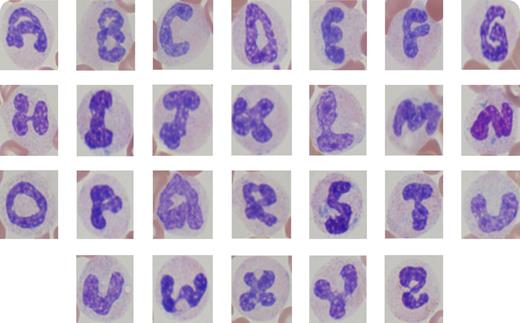An 80-year-old man was hospitalized with symptoms of progressive cough, fever, and dyspnea over a period of 5 days. Chest x-ray showed bilateral lobar pneumonia. A complete blood count revealed white blood cell count of 42.3 × 109/L, hemoglobin 12.4 g/dL, platelets 155 × 109/L, and mean corpuscular volume 91.2 fL. Morphologic examination of the peripheral blood smear revealed a manual leukocyte differential of 81% segmented neutrophils, 12% bands, 2% monocytes, and 5% lymphocytes. The patient was treated with antibiotics and his leukopenia resolved completely.
Features of prominent Dohle bodies (letters N and S); cytoplasmic vacuolation (letters L, M, and W); and toxic granulation (letters I and S) represent toxic changes consistent with reactive neutrophilia secondary to acute pneumonia. Atypical nuclear segmentation generated a complete modern English alphabet and is a result of accelerated neutrophil maturation.
An 80-year-old man was hospitalized with symptoms of progressive cough, fever, and dyspnea over a period of 5 days. Chest x-ray showed bilateral lobar pneumonia. A complete blood count revealed white blood cell count of 42.3 × 109/L, hemoglobin 12.4 g/dL, platelets 155 × 109/L, and mean corpuscular volume 91.2 fL. Morphologic examination of the peripheral blood smear revealed a manual leukocyte differential of 81% segmented neutrophils, 12% bands, 2% monocytes, and 5% lymphocytes. The patient was treated with antibiotics and his leukopenia resolved completely.
Features of prominent Dohle bodies (letters N and S); cytoplasmic vacuolation (letters L, M, and W); and toxic granulation (letters I and S) represent toxic changes consistent with reactive neutrophilia secondary to acute pneumonia. Atypical nuclear segmentation generated a complete modern English alphabet and is a result of accelerated neutrophil maturation.
For additional images, visit the ASH IMAGE BANK, a reference and teaching tool that is continually updated with new atlas and case study images. For more information visit http://imagebank.hematology.org.


This feature is available to Subscribers Only
Sign In or Create an Account Close Modal